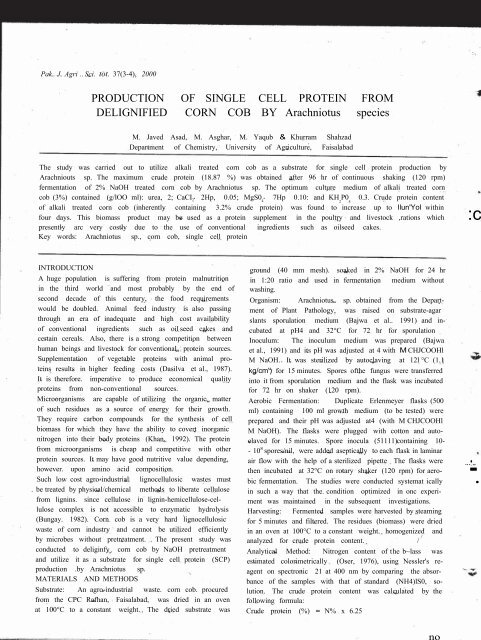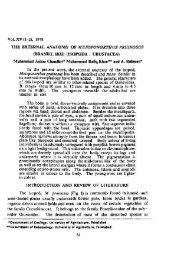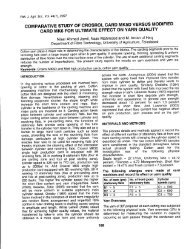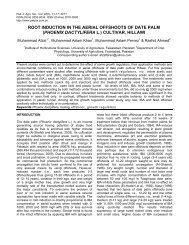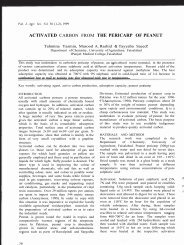PRODUCTION OF SINGLE CELL PROTEIN FROM DELIGNIFIED ...
PRODUCTION OF SINGLE CELL PROTEIN FROM DELIGNIFIED ...
PRODUCTION OF SINGLE CELL PROTEIN FROM DELIGNIFIED ...
Create successful ePaper yourself
Turn your PDF publications into a flip-book with our unique Google optimized e-Paper software.
Pak. J. Agri .. Sci. tot. 37(3-4), 2000<br />
<strong>PRODUCTION</strong> <strong>OF</strong> <strong>SINGLE</strong> <strong>CELL</strong> <strong>PROTEIN</strong> <strong>FROM</strong><br />
<strong>DELIGNIFIED</strong> CORN COB BY Arachniotus species<br />
M. Javed Asad, M. Asghar, M. Yaqub & Khurram Shahzad<br />
Department of Chemistry, University of Agriculture, Faisalabad<br />
The study was carried out to utilize alkali treated corn cob as a substrate for single cell protein production by<br />
Arachniouts sp. The maximum crude protein (18.87 %) was obtained after 96 hr of continuous shaking (120 rpm)<br />
fermentation of 2% NaOH treated corn cob by Arachniotus sp. The optimum culture medium of alkali treated corn<br />
cob (3%) contained (g/lOO ml): urea, 2; CaCI2• 2Hp, 0.05; MgS0 7Hp 0.10: and KH P0 0.3. Crude protein content<br />
4 2 4<br />
of alkali treated corn cob (inherently containing 3.2% crude protein) was found to increase up to Ilun'YoI within<br />
four days. This biomass product may be used as a protein supplement in the poultry and livestock ,rations which :c<br />
presently arc very costly due to the use of conventional ingredients such as oilseed cakes.<br />
Key words: Arachniotus sp., corn cob, single cell protein<br />
INTRODUCTION<br />
A huge population is suffering from protein malnutrition<br />
in the third world and most probably by the end of<br />
second decade of this century, the food requirements<br />
would be doubled. Animal feed industry is also passing<br />
through an era of inadequate and high cost availability<br />
of conventional ingredients such as oil seed cakes and<br />
certain cereals. Also, there is a strong competition between<br />
human beings and livestock for conventional protein sources.<br />
Supplementation of vegetable proteins with animal proteins<br />
results in higher feeding costs (Dasilva et al., 1987).<br />
It is therefore. imperative to produce economical quality<br />
proteins from non-conventional sources.<br />
Microorganisms are capable of utilizing the organic matter<br />
of such residues as a source of energy for their growth.<br />
They require carbon compounds for the synthesis of cell<br />
biomass for which they have the ability to covert inorganic<br />
nitrogen into their body proteins (Khan, 1992). The protein<br />
from microorganisms is cheap and competitive with other<br />
protein sources. It may have good nutritive value depending,<br />
however. upon amino acid composition.<br />
Such low cost agro-industrial lignocellulosic wastes must<br />
. be treated by physical/chemical methods to liberate cellulose<br />
from lignins. since cellulose in lignin-hemicellulose-cellulose<br />
complex is not accessible to enzymatic hydrolysis<br />
(Bungay. 1982). Corn cob is a very hard lignocellulosic<br />
waste of corn industry and cannot be utilized efficiently<br />
by microbes without pretreatment. The present study was<br />
conducted to deliginfy corn cob by NaOH pretreatment<br />
and utilize it as a substrate for single cell protein (SCP)<br />
production .by Arachniotus sp.<br />
MATERIALS AND METHODS<br />
Substrate: An agro-industrial waste. corn cob. procured<br />
from the CPC Rafhan, Faisalabad, was dried in an oven<br />
at 100°C to a constant weight. The dried substrate was<br />
ground (40 mm mesh). soaked in 2% NaOH for 24 hr<br />
in 1:20 ratio and used in fermentation medium without<br />
washing.<br />
Organism: Arachniotus sp. obtained from the Department<br />
of Plant Pathology, was raised on substrate-agar<br />
slants sporulation medium (Bajwa et al.. 1991) and incubated<br />
at pH4 and 32°C for 72 hr for sporulation<br />
Inoculum: The inoculum medium was prepared (Bajwa<br />
et al., 1991) and its pH was adjusted at 4 with M CHJCOOHl<br />
M NaOH. It was sterilized by autoclaving at 12l °C (1.1<br />
kg/cm') for 15 minutes. Spores ofthe fungus were transferred<br />
into it from sporulation medium and the flask was incubated<br />
for 72 hr on shaker (120 rpm).<br />
Aerobic Fermentation: Duplicate Erlenmeyer flasks (500<br />
ml) containing 100 ml growth medium (to be tested) were<br />
prepared and their pH was adjusted at4 (with M CHJCOOHl<br />
M NaOH). The flasks were plugged with cotton and autoclaved<br />
for 15 minutes. Spore inocula (51111)containing 10-<br />
-10 8 spores/nil, were added aseptically to each flask in laminar<br />
air flow with the help of a sterilized pipette The flasks were<br />
then incubated at 32°C on rotary shaker (120 rpm) for aerobic<br />
fermentation. The studies were conducted systemat ically<br />
in such a way that the. condition optimized in onc experiment<br />
was maintained in the subsequent investigations.<br />
Harvesting: Fermented samples were harvested by steaming<br />
for 5 minutes and filtered. The residues (biomass) were dried<br />
in an oven at 100°C to a constant weight. homogenized and<br />
analyzed for crude protein content. /<br />
Analytical Method: Nitrogen content of the b~lass was<br />
estimated colorimetrically (Oser, 1976), using Nessler's reagent<br />
on spectronic 21 at 400 nm by comparing the absorbance<br />
of the samples with that of standard (NH4)lS0, solution.<br />
The crude protein content was calculated by the<br />
following formula:<br />
Crude protein (%) = N% x 6.25<br />
no<br />
~- \<br />
- ...•..
RESULTS AD DISCUSSION<br />
Optimization of Fermentation Parameters<br />
Fermentation Period: The results revealed that biomass<br />
produced after 24. 48, 72, 96 and 120 hr of incubation<br />
contained8.02. 10.15, 10.67, 11.20and 10.75%crude protein<br />
respectivelly (Table I). It was observed that maximum<br />
biomass protein (11.20%) was produced after 96 hr of<br />
incubation and gradually decreased thereafter, up to 120<br />
hr. Similar results have been reported by Bajwa et al.<br />
(1991) who produced maximum crude protein from alkali<br />
treated rice straw by Archniotus sp. with shaking at 30°C<br />
for 48 hr under optimum conditions.<br />
Table 1. Crude protein content of biomass produced by<br />
Arachniotus sp. at different fermentation periods<br />
and varying concentrations of substrate and urea<br />
Sr. . Fermentation Substrate Urea Crude<br />
No. period (hr) level (%) protein (%)<br />
24<br />
8.02<br />
48<br />
10.15<br />
I ·72<br />
%<br />
120<br />
. I<br />
2<br />
10.67<br />
11.20<br />
10.75<br />
9.47<br />
11.22<br />
2 % 3<br />
4<br />
13.39<br />
12.80<br />
5<br />
12.16<br />
0.0 13.24<br />
I 14.36<br />
3 % 3 2 15.48<br />
3 14.87<br />
4 13.65<br />
2<br />
Asad, Asghar. Yaqub & Shahzad<br />
Table 2. Crude protein content of biomass produced by<br />
Arachniotus sp, with varying concentrations of<br />
KH 2 PO 4 under optimum conditions'"<br />
0.0<br />
0.1<br />
0.2<br />
0.3<br />
0.4<br />
Crude protein (%)<br />
17.42<br />
17.64<br />
17.95<br />
18.87<br />
18.37<br />
* Substrate3 'Yo. urea, 2 %, CaCI 2 , 2Hp 0.05 %; MgSO4' 7Hp<br />
o.oi %; pH 4 and 32°C<br />
18<br />
17.5<br />
-. 17<br />
"it. '-'<br />
.8<br />
1 16.5<br />
1 16<br />
U<br />
15.5<br />
15<br />
14.5<br />
0<br />
0.01<br />
0.05<br />
Concentration (%)<br />
.. . C8C1 2 ·2II 2 0<br />
__ MgSo.·7H 2 0<br />
Fig. 1. Effect of vuyblg eeneentratiou of CaCJ,.2H,O<br />
Dd MgSO 7H 20 OD SCP prodaetion.<br />
Substrate Level: Results regarding the crude protein<br />
content of the biomass produced with different substratc<br />
levels have been given in Table I. It was noted that<br />
with an increase in substrate level the crude protein content<br />
ofthe biomass increased and reached a maximum of 13.19~1"<br />
with 3% substrate. These results are supported by Alam<br />
(1986) who reported maximum crude protei II (17.2 vy.,)<br />
production by Arachniotus sp. after 72 hr iacubation with<br />
5% (w/v) rice polishing.<br />
Urea: It was observed that addition of urea enhanced<br />
SCP production by Arachiotus sp. Addition of 1. 2. 1<br />
and 4% urea to the fermentation medium under optimum<br />
conditions resulted in 13.96, 15.48, 14.87 and 1165%crude<br />
protein respectivey after 96 hr. The results are in agreement<br />
with those of Moo-Young et al. (1992) who used different<br />
nitrogen containing compounds such as (NH,), SO,. O.47g<br />
and urea 0.86g and observedmaximum crude protein (31 1'%)<br />
in the medium containing urea as a nitrogen source.<br />
CaCI 2 .2H 2 0: The results in terms of crude protein percentage<br />
have been presented in Table 1. It was observed that<br />
addition of CaCI 2 .2Hp had favourable effect 011 SCP<br />
production. Crude protein content of biomass increased<br />
from 15.39 to 16.24% and 0.05% CaC1:.2Hp produced<br />
higher biomass protein than cotnrol (without CaCI,.2H,O)<br />
and all other concentrations of this salt.. These -results<br />
are in accordance with those of Chahal et al. (1987) who<br />
produced maximum biomass protein (40%) from corn stover<br />
by Pleurotus sajorcaju with 0.03% CaC1:.2Hp along with<br />
optimum concentrations of other micronutrients.<br />
MgSO 4' 7~ 0: The resultsindicated that 0.It)'!;.,MgSO"7H:O<br />
in the medium gave the highest SCP yield. The crude<br />
protein content of the biomass increased with the addition'<br />
ofMgS0 4 .7Hpand reached its maximum (17.4R%)at O.W'y.,<br />
level under optimum conditions.<br />
0.\<br />
0.15
Hongpattarakere and Kittikun (1995) fermented cassava<br />
by Schwanniomyces castellii and reported 0.1 % MgSO 4'7Hp<br />
. as optimum for the production of maximum biomass protein<br />
(7.4 g/ I00 g of starch).<br />
KH PO 4; The maximum<br />
2<br />
crude protein yield (18.87%) was<br />
recorded with 0.3% KHl04 in the medium which was<br />
considered as the optimum level of this salt. The results<br />
of this study are in line with those of Hashmi et al.<br />
(1991) who also reported 0.2% KHl04 as optimum for<br />
maximum SCP production by Arachniotus sp. Aalia et<br />
al. (1998) reported an increase in crude protein with addition<br />
of 0.3% KH:P04 to corn stover medium fermented with<br />
Arachniotus<br />
REFERENCES<br />
sp.<br />
Aaha. S.. M. Rashid, M. Asghar and M. Yaqub. 1998.<br />
Bioconvcrsion of corn stover into biomass proetin by<br />
Anachniotus sp. Pak. 1. BioI. Sci. 1(2):78-80.<br />
Alam, R.S. 1986. Production of basic amino acids by<br />
Arachniotus sp. M.Sc. Thesis. Univ. Agri .. Faisalabad.<br />
Bajwa, M. A.. T. Aziz aand A.S. Hashmi. 1991. Production<br />
of fungal 'biomass protein from alkali treated rice straw<br />
by Arachniotus sp. JAPS. 1(2):79-81.<br />
Bungay.<br />
646.<br />
H.R. 1982. Biomass refining. Science. 218:643-<br />
Production of single cell protein<br />
Chahal, D.S .. M. Ishaque, D. Broiullard. E. Chornct. R.P<br />
Overend, L. Jaulin and 1. Bouchard. 19R7. Bioconversion<br />
of hemicelluloses into fungal protein. J. Microbiol<br />
78:355-361.<br />
Dasilva, £.1.. Y.R. Dommergues, E.J. Nyns and C. Ratbdge.<br />
1987. Mircobial Technology in the Developing World.<br />
Oxford Univ. Press. Oxford. U.K:239.<br />
Hashmi, A.S .. K.K. Batajoo and M.A. Bajwa. 1991.<br />
Bioconversion of rice straw into protein concentrate with<br />
Arachniotus sp. Proc. Int. Symp. Biotechnologv for Energy<br />
16-21 Dec. 1969. Faisalabad, Pakistan: 149-155.<br />
Hongpattarakere, T. and A.H. Kittikun. }995. Optimization<br />
of single cell protein production from cassava starch using<br />
Schwanniomyces<br />
11:607-609.<br />
castellii. World J. Microbiol. Biotechnol.<br />
Khan. M.Y.. M.U. Dahat and M.Y. Khan. 19


